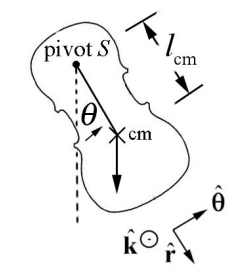24.2: Physical Pendulum
( \newcommand{\kernel}{\mathrm{null}\,}\)
A physical pendulum consists of a rigid body that undergoes fixed axis rotation about a fixed point S (Figure 24.2).

The gravitational force acts at the center of mass of the physical pendulum. Denote the distance of the center of mass to the pivot point S by lcm. The torque analysis is nearly identical to the simple pendulum. The torque about the pivot point S is given by
→τS=→rS,cm×m→g=lcmˆr×mg(cosθˆr−sinθˆθ)=−lcmmgsinθˆk
Following the same steps that led from Equation (24.1.1) to Equation (24.1.4), the rotational equation for the physical pendulum is
−mglcmsinθ=ISd2θdt2
where Is the moment of inertia about the pivot point S. As with the simple pendulum, for small angles sinθ≈θ, Equation (24.2.2) reduces to the simple harmonic oscillator equation
d2θdt2≃−mglcmISθ
The equation for the angle θ(t) is given by
θ(t)=Acos(ω0t)+Bsin(ω0t)
where the angular frequency is given by
ω0≃√mglcmIS( physical pendulum )
and the period is
T=2πω0≃2π√ISmglcm( physical pendulum )
Substitute the parallel axis theorem, IS=ml2cm+Icm into Equation (24.2.6) with the result that
T≃2π√lcmg+Icmmglcm( physical pendulum )
Thus, if the object is “small” in the sense that Icm<<ml2c, the expressions for the physical pendulum reduce to those for the simple pendulum. The z -component of the angular velocity is given by
ωz(t)=dθdt(t)=−ω0Asin(ω0t)+ω0Bcos(ω0t)
The coefficients A and B can be determined form the initial conditions by setting t = 0 in Equations (24.2.4) and (24.2.8) resulting in the conditions that
A=θ(t=0)≡θ0B=ωz(t=0)ω0≡ωz,0ω0
Therefore the equations for the angle θ(t) and ωz(t)=dθdt(t) are given by
θ(t)=θ0cos(ω0t)+ωz,0ω0sin(ω0t)ωz(t)=dθdt(t)=−ω0θ0sin(ω0t)+ωz,0cos(ω0t)

